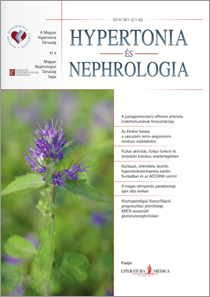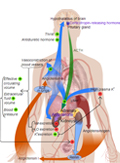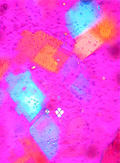The eLitMed.hu medical portal uses computer cookies for convenient operation. Detailed information can be found in the Cookie-policy.
Hypertension and nephrology - 2014;18(01-02)
Content
[Fenestration of endothelium of juxtaglomerular arteriole]
[For the first time, we demonstrated the fenestration in the endothelium of the distal portion of renal afferent arteriole (AA), which is unusual among high pressure vessels. The fenestrae are co-localized with renin producing granular epithelioid cells; this arrangement makes it likely that the relatively large renin molecules may use this path to enter into the plasma. We also demonstrated that the length and area of this fenestrated segment 1) correlates with the activity of the renin-angiotensin system (RAS), 2) may change by age, in response to some stimuli such as thirst and in some diseases, 3) allows filtration of fluid prior to the glomerular filtration, which can be as high as about 30% of GFR. This morphology and the high filtration volume in AA is one of the most striking observations of renal microcirculation, and question several basic renal physiological issues.]
[Effect of age on the function of renin-angiotensin system]
[Angiotensin II (Ang II) by activating angiotensin type 1 receptors (AT1R) is one of the most potent vasoconstrictors in the regulation of vasomotor tone and thus systemic blood pressure. In this study, we hypothesized that aging alters Ang II - induced vasomotor responses and expression of vascular mRNA and protein angiotensin type 1 receptor (AT1R). Thus, carotid arteries were isolated from newborn, young, middle age, old and senescent rats and their vasomotor responses were measured in a myograph (DMT-600) to repeated administrations of Ang II. Vascular relative AT1R mRNA level was determined by qRT-PCR and the AT1R protein density was measured by Western blot. Contractions of vessels to the first administration of Ang II increased from newborn to young and middle age rats then they decreased to senescent rats. In general, second administration of Ang II elicited reduced contractions, but they also first increased and then they decreased to old age. Similarly, the AT1R mRNA level and the AT1R protein density increased from newborn to young and middle age rats then they decreased to senescent rats. The pattern of these changes correlated with functional vasomotor data. We conclude that aging (newborn to senescence) has substantial effects on Ang II-induced vasomotor responses and AT1R signaling suggesting that it is - and thus regulation of systemic blood pressure is - determined primarily by genetic programs.]
[Physical activity, physical function and exercise in chronic kidney disease]
[This review summarize the decreased physical activity and physical function of chronic kidney disease patients from the early stage of their renal disease; the favourable effects of exercise training on physical activity and function as well as on progression of chronic renal diseases. At the end, there is a recommendation for implementation of exercise in this renal patient population. The conclusion is that, on the basis of the evidences patients with chronic renal disease should be advised to increase their physical activity in all stages of their renal disea]
[Risk categories, goals and treatment of hypercholesterolemia in Europe and in the recommendations of the AHA/ACC]
[Hypercholesterolemia is one of the most important major risk factors that can be most influenced. Its treatment is based on guidelines. In 2013 in Hungary the common guideline of 17 societies (MKKK) as well as the recommendations of EAS/ESC and those of IAS are at disposal. These recommendations have established similar risk categories and strict LDL-cholesterol goals (<1.8 mmol/l). On 12 November, 2013, in the USA after a long drawn debate the AHA/ACC - without any lipid association - issued a new cholesterol (Ch) guideline, which drasticly differs from the existing national and European recommendations. According to AHA/ACC each patient with cardiovascular disease or diabetes should be treated with statin, irrespective of the Ch value, All patients with a LDL-Ch level over 4.9 mmol/l should also be treated with statin. In primary prevention those with values between 1.8-4.9 (LDL-Ch), or 3.5-8.0 mmol/l (Ch) would also be given statin, if their risk is more than 7.5%, with the new calculator system (“Statin Benefit Groups”). These recommendations would eliminate the classic risk categories (very-high, high, moderate risk), would abolish the system of treatment goals, as well as the regular Ch test. The non-statin therapy is not supported even in combinations. A big part of the population with low Ch level would also receive statin based on the results with the calculator, meaning that in the USA the number of those treated might double. Not only the European (e.g. EAS/,ESC) but even American societies (National Lipid Association 2013-2014) (e.g. NLA) oppose to the new guideline of AHA/ACC.]
[Blood presssure paradoxon in very elderly patients]
[The paper is warning for the necessity of very complex consideration before taking antihypertensive therapeutic decisions (indication, point or points of actiou, blood pressure target levels, dynamics of BP reduction, etc) for elderly hypertensive patients. Blood pressure reduction can mean efficient protection against cardiovascular events also among the elderly hypertensives. However in those old and very old hypertensive patients who have not only severe stiffness of their large vessels but suffer in advanced co-morbidities and integrated pathologic geriatric syndromes, the blood pressure reduction can result in sometimes even life threatening general deterioration. Antihypertensive therapeutic dilemmas of elderly caregivers appear mainly in relation to old hypertensive patients of age over 80 years. For this „very old” age period the HYVET study gave us evidence based conclusions about the cardiovascular protective usefulness of combined antihypertensive treatment resulting in BP reduction to 150 Hgmm systolic BP target levels. However a non-negligable rate of selection of the included patients in HYVET study can weaken the generalizability of the HYVET findings in this age period and the extensibility of its antihypertensive therapeutic conclusions for the entire „very old” population because this population has also a high proportion of patients with chronic progressive illnesses and general decline. Thus the elderly hypertensives’ caregiver must always carefully and critically balance between the messages of the HYVET and the nonselective observational follow up studies among elderlies showing frequently the so-called epidemiologic blood pressure/ mortality paradoxon. The paper is also trying to find potencial pathomechanical interpretations and point of actions for the epidemiologic blood pressure/mortality paradoxon found in the very old population.]
[Prognostic value of histopatologic classification in ANCA-association vasculitis]
[Introduction: Rapidly progressive glomerulonephritis is life-threatening manifestation of antineutrophil cytoplasmatic antibody (ANCA)-associated vasculitis (AAV), often diagnosed only in advanced stage of renal failure. In 2010 a new histopathologic classification of ANCA- associated vasculitis was published by an international working group of nephropathologists. Vasculitis cases were classified in four groups: focal, crescent, mixed and sclerotic. Method: The aim of our study was to re-evaluate the predictive value of this new classification regarding renal outcome. From the 88 patients with ANCA-associated vasculitis treated in our department from 1996 to 2013, 39 were involved. Results: By retrospective evaluation of biopsy samples, patients were classified as 11 in focal, 12 in crescent, eight in mixed, eight in sclerotic group. There was no significant difference among the four groups regarding the mean age, sex, ANCAtype and initial eGFR. Due to the treatment, the eGFR values significantly increased in the focal and in the crescent groups. Eleven patients needed dialysis at presentation and three of them recovered, none of them belonged to the sclerotic group. The cumulative renal response to treatment was 100% in the focal, 87.5% in the mixed, 64% in the crescent and 62% in the sclerotic group. Renal response at one year treatment was 80%, thirty-one of the thirty-nine patients were dialysis independent. All patients were alive at one year, by year five two patients from the sclerotic group died. Conclusion: The new nephropathological classification of AAV is useful in predicting the renal response to treatment. Nephropathology can optimize the system by mentioning the specific percentage of normal glomeruli in the biopsy specimen.]
[The beginnings and difficulties of peritoneal dialysis at the end of the last century. Part II. Hungarian experiences]
[In Part I, I summarised the beginnings, the theoretical background and the international experiences of peritoneal dialysis. Hungarian publications related to peritoneal dialysis in the 1950s were focusing on the role of the method in the treatment of chronic renal disorders. The first dialysis centres were established in the medical universities of Hungary (Szeged in 1955, Budapest in 1960, Pécs in 1964, Debrecen in 1970) and in Miskolc in 1968. Despite the restricted hemodialysis capacities the intermittent technique of peritoneal dialysis did not spread in accordance with the demand. A survey conducted at the beginning of the 1970’s in the territory of the five counties with 1.5 million inhabitants revealed that considering the numbers of patients with renal diseases requiring dialysis, developing of a network of care and increasing the dialysis capacities is necessary and so is the development of a system of szatellite peritoneal dialysis, which was implemented with our support in 10 units of the county hospitals. A devoted and enthusiastic organiser of the nation-wide system of peritoneal dialysis was professor Taraba, who, due to his untimely death, was deprived of seeing the nation-wide spread of CAPD. At the beginning of the 1980’s the first reports on the favourable effects of CAPD appeared in Hungary. Solutions prepared in pharmacies and the lack of up-to-date equipment resulted in the frequent occurrence of peritonitis. In addition, the unfavourable memories of dialysis performed with bottled solutions (long treatment times, frequently peritonitis) were still vivid among patients and colleagues supervising the treatment. As a consequence, our survey conducted in 1991 revealed that the spread of CAPD all over the world in Hungary resulted in a significant increase of those treated with the intermittent method (more than 10% of the dialysis patients), while those treated with CAPD remained under 2%. Several reports on CAPD and the consequences that followed from them as well as the further training organised in the Szent Margit Hospital, Budapest and in Gánt, and also the guidelines issued by the Society of Hungarian Nephrologists the number of those treated with dialysis has exceeded 6000 in the past decade. 10% of them received CAPD/APD treatment.]
1.
Clinical Neuroscience
Is there any difference in mortality rates of atrial fibrillation detected before or after ischemic stroke?2.
Clinical Neuroscience
Factors influencing the level of stigma in Parkinson’s disease in western Turkey3.
Clinical Neuroscience
Neuropathic pain and mood disorders in earthquake survivors with peripheral nerve injuries4.
Journal of Nursing Theory and Practice
[Correlations of Sarcopenia, Frailty, Falls and Social Isolation – A Literature Review in the Light of Swedish Statistics]5.
Clinical Neuroscience
[Comparison of pain intensity measurements among patients with low-back pain]1.
Clinical Neuroscience Proceedings
[A Magyar Stroke Társaság XVIII. Kongresszusa és a Magyar Neuroszonológiai Társaság XV. Konferenciája. Absztraktfüzet]2.
3.
Journal of Nursing Theory and Practice
[A selection of the entries submitted to the literary contest "Honorable mission: the joys and challenges of our profession" ]4.
Journal of Nursing Theory and Practice
[End of Life and Palliative Care of Newborns in the Nursing Context]5.
Journal of Nursing Theory and Practice
[Aspects of Occupational Health Nursing for Incurable Patients ]




